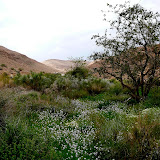Jason's sister Beth, her husband Dick, and their two boys,
Berni and Jesse took a family trip to Israel. Though they wanted to
visit with us, they also spent a portion of their trip volunteering. We had a
great time with them, but their trip was about much more than just visiting
family and being tourists. Here's what they had to say:
Our trip to Israel far exceeded our expectations. By
coordinating with the Jewish Agency for Israel and the Jewish Federation of W.
Mass. we were able to plan a trip that gave our family an Israel experience far
beyond a tour of the country.
When we first arrived in Israel we stayed with family in Haifa. During the several days we spent in that port city we shopped at an outdoor market in an Arab neighborhood, strolled around the Old City of Akko, swam in the Mediterranean Sea, and toured the subterranean caves of Rosh Hanikrah.
From Haifa we drove southeast to Afula for our volunteer work. In between our volunteer activities we toured the remains of a Crusader-era castle at Belvoir National Park, swam in spring-fed waters at Gan Hashlosha, visited tombs in burial caves at Bet She'arim, and returned to Haifa for a tour of the Marine Biology Department at Haifa University.
 |
| Exploring Belvoir Castle |
Our first volunteer experience was with Project Leket at
Moshav Nahalal, where we picked beets for underprivileged families. After
two hours of gleaning, the volunteer coordinator showed us the huge plastic
crate we had filled and told us it would feed 133 families in need! This
experience taught our children the true meaning of Tikkun Olam, repairing the
world.
 |
| Picking beets at Moshav Nahalal |
On the same day we picked beets, we also volunteered at a
community public library located in Afula and operated by The Tarbut (Cultural)
Movement. Here we helped sort games and puzzles that had been donated for
underprivileged children from one of Afula's rougher neighborhoods. A group of
young adults told the story of The Tarbut Movement, a non-profit national
movement of pioneering young artists who reside and work as Tarbut Communities
('urban kibbutzim') in weakened towns and cities throughout Israel. The group
uses art and culture as a vehicle for self-empowerment and social change to
reshape the future of Israel, promoting values of social solidarity, equality,
democracy and tolerance. The young adults we met were inspirational and served
as wonderful role models for our children.
 |
| Sorting puzzles |
The next day we volunteered at the Bet Alfa Absorption
Center, a Jewish Agency facility for new immigrants from Ethiopia. While our
children played games with the Ethiopian children, a middle-aged Ethiopian
woman told us her story of how she came to Israel from her native country 30
years ago. It was an emotional first-hand account of a long journey filled with
hopes and fears and it is a story we will never forget. Afterwards, our whole
family helped the children plant flower boxes of herbs. When it was finally
time to say goodbye, nobody wanted us to leave! We all wish we could have spent
more time there.
 |
| Children at the Bet Alfa Absorption Center |
Later that evening the Gilboa family hosted us for dinner on
a moshav near the Bet Alpha Absorption Center. The family has four daughters,
all of whom got along wonderfully with our two boys. The food was amazing and
there was so much of it we couldn't possibly try it all. We talked to the
Gilboas about family life in Israel and, more specifically, living on a moshav.
It was a wonderful evening and we were so grateful for the opportunity to eat
and socialize with the Gilboas.
While engaging in volunteer work in the Afula region we
stayed at Kibbutz Yizreel, where we experienced life on a kibbutz. Every
morning we ate breakfast at the dining hall and talked to several residents to
learn what it is like to live on the kibbutz. Our host's husband gave us a tour
of the kibbutz's factory, which manufactures automated pool cleaners. The
whole experience was fascinating and led to many family conversations about
communal living.
 |
| The scenic Gilboa Heights |
From Afula we drove southeast again to view the Dead Sea.
Then we drove west to Jerusalem, where we stayed in a hotel for two nights.
During our trip to Jerusalem we walked on the ramparts of the Old City, prayed
at the Kotel, and toured the tunnels underneath the Kotel. On our last day in
Jerusalem we visited Mahane Yehuda Market, a large indoor/outdoor market with
fresh fruits, vegetables, meats, fish, cheeses and much more. We shopped at the
market on a Friday morning and it was packed with people buying food in
preparation for Shabbat.
 |
| Berni, Jesse, and Jason at Mahane Yehuda Market |
 |
| Buying cheese at Mahane Yehuda |
From Jerusalem we drove northwest to Hashmonaim, a yishuv
located about 15 minutes southeast of Tel Aviv. Here we spent Shabbat in an
observant community. After Shabbat we visited Yad Lashiryon in Latrun, which
houses over 200 armored tanks, many of which were used in the Six-Day and
the Yom Kippur wars. We also toured the Bell Caves at Bet Guvrin. Later that
night we had dinner with family and traveled to Tel Aviv for our flight home.
 |
| Getting to know our cousins |
 |
| Yad Lashiryon |

































